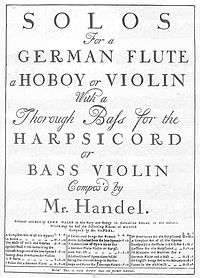John Walsh (printer)
John Walsh (1665 or 1666 – 13 March 1736) was an English music publisher of Irish descent, established off the Strand, London, by c. 1690. He was appointed musical instrument-maker-in-ordinary to the king in 1692.
Walsh began publishing music in 1695, at which time he had few rivals in the trade. The firm established by John Playford in 1647 was in decline under his son Henry, and Thomas Cross was more involved with engraving than publishing. Walsh took advantage of this situation, and soon his firm was printing engraved music on a scale previously unknown in England. In addition to English composers, he published a good deal of music by foreign composers, which he often copied from Dutch editions (Kidson et al. 2001a).
Among his innovations were the use of softer but cheaper pewter rather than copper for the shorter runs of most music, and the introduction of punches (Kidson et al. 2001a).
From 1711 he published Handel's works, beginning with Rinaldo. He also issued two periodicals, The Monthly Mask of Vocal Music and Harmonia anglicana. From about 1716 he started to collaborate with Estienne Roger in Amsterdam. Walsh was also a distributor for Roger's editions, many of which survive with Walsh's label (Kidson et al. 2001a).
John Walsh the younger

Around 1730 his son John (1709–66) took control of the business, and was responsible for developing the firm's relationship with Handel from that time onward. About half of Walsh's output was of Handel compositions (Kidson et al. 2001b).
In the 1732 publication of Handel's solo sonatas, the following was printed on the cover page: "Printed and Sold by John Walsh at the Harp and Hoboy in Catherine Street in the Strand". The cover also displayed other works by Handel that had been printed by Walsh, and the prices for those publications.
In 1738 Walsh published a set of keyboard concertos, Handel's organ concertos, Op. 4. In 1739 he was granted a monopoly on Handel's music for 14 years.
Legacy
A collection of music printed by Walsh and his son, including Arcangelo Corelli's church trio sonatas Op. 1 and Attilio Ariosti's opera Vespasiano, was displayed at the Lobkowicz Palace in Prague in 2015. During his travels in England, Ferdinand Philip, 6th Prince Lobkowicz, acquired a large selection of music printed by Walsh.
Sources
- Hunter, David. 2002. "George Frideric Handel as Victim: Composer-Publisher Relations and the Discourse of Musicology". In Encomium Musicae: Essays in Memory of Robert J. Snow, edited by David E. Crawford and George Grayson Wagstaff, 663–92. Festschrift series, No. 17. Hillsdale: Pendragon Press. ISBN 0-945193-83-1.
- Kidson, Frank, William C. Smith, Peter Ward Jones, and David Hunter. 2001a. "Walsh, John (i)". The New Grove Dictionary of Music and Musicians, second edition, edited by Stanley Sadie and John Tyrrell. London: Macmillan Publishers.
- Kidson, Frank, William C. Smith, Peter Ward Jones, and David Hunter. 2001b. "Walsh, John (ii)". The New Grove Dictionary of Music and Musicians, second edition, edited by Stanley Sadie and John Tyrrell. London: Macmillan Publishers.
- Smith, William Charles. 1948 A Bibliography of the Musical Works Published by John Walsh During the Years 1695–1720. Bibliographical Society Publication 1941. London: Bibliographical Society.
- Smith, William Charles, and Charles Humphries. 1968. A Bibliography of the Musical Works Published by the Firm of John Walsh During the Years 1721–1766. London: Bibliographical Society.
- Swack, Jeanne. 1993. " John Walsh's Publications of Telemann's Sonatas and the Authenticity of 'Op. 2'". Journal of the Royal Musical Association 118, no. 2:223–45.
See also
- Handel solo sonatas (publication by Walsh)
- Frank Kidson, et al., "Walsh, John (i)" in Grove Music Online.